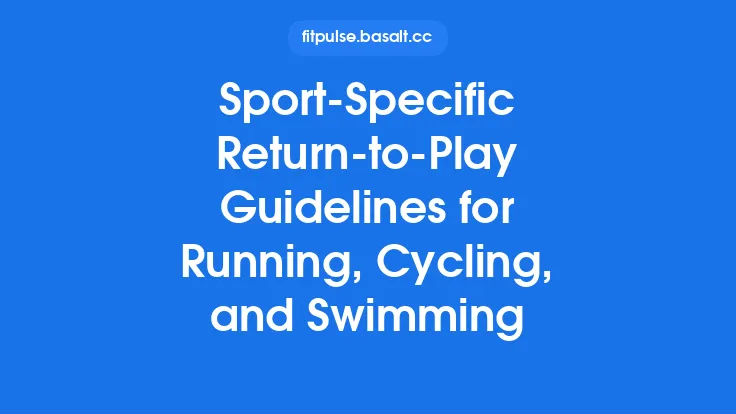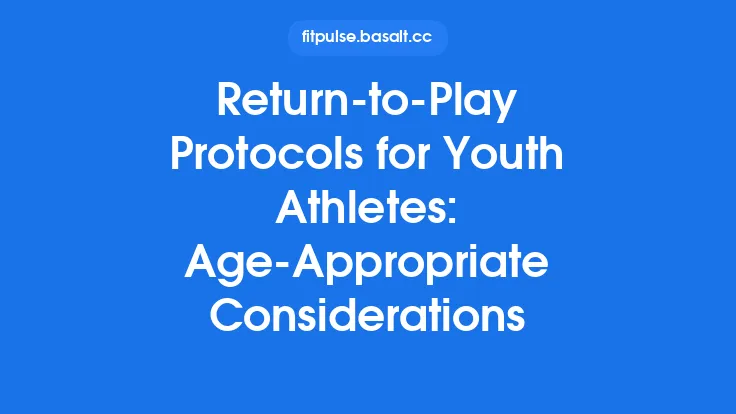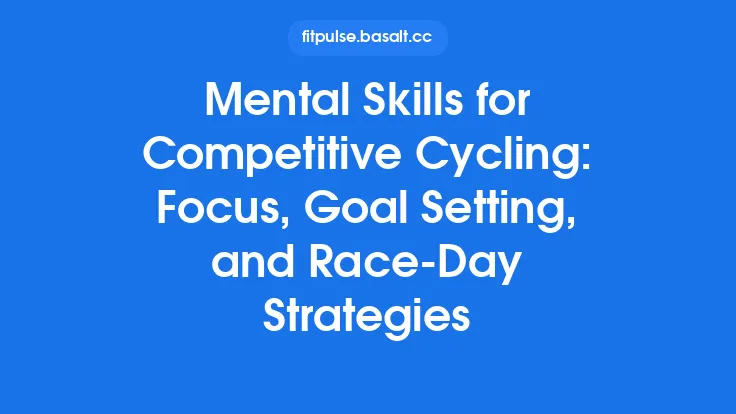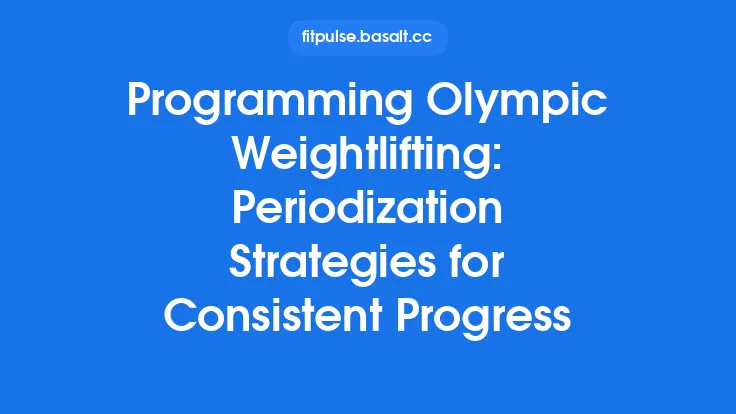Returning to competition after an injury is as much a mental challenge as it is a physical one. Even when the body has healed enough to meet the objective criteria for a safe return, lingering doubts, fear of re‑injury, and a shaken sense of athletic identity can undermine performance and increase the risk of setbacks. Psychological readiness— the athlete’s confidence, motivation, and mental resilience— is therefore a critical, yet often under‑appreciated, component of a successful comeback. This article explores the core mental strategies that empower athletes to step back onto the field, court, or track with confidence, and offers practical tools for coaches, clinicians, and athletes themselves to cultivate a robust psychological foundation for competition.
Understanding Psychological Readiness
Psychological readiness refers to the athlete’s mental state regarding confidence, anxiety, motivation, and perceived competence to perform at pre‑injury levels. It is distinct from physical readiness, which is measured by strength, range of motion, and functional performance. While physical metrics can be objectively quantified, psychological readiness is inherently subjective and multidimensional, encompassing:
| Dimension | Description | Typical Indicators |
|---|---|---|
| Self‑efficacy | Belief in one’s ability to execute sport‑specific tasks | Positive self‑talk, willingness to attempt challenging drills |
| Fear of re‑injury | Anticipatory anxiety about sustaining another injury | Hesitation during high‑impact movements, hyper‑vigilance |
| Motivation | Drive to train, compete, and improve | Consistent training adherence, goal‑oriented behavior |
| Emotional regulation | Ability to manage stress, frustration, and disappointment | Calmness under pressure, rapid recovery from setbacks |
| Athletic identity | Sense of self tied to sport participation | Engagement in sport‑related activities, confidence in role within the team |
Research consistently shows that athletes who report high psychological readiness are more likely to achieve successful return‑to‑play outcomes, maintain performance levels, and experience lower rates of re‑injury. Consequently, addressing mental factors should be integrated into any comprehensive return plan.
Assessing Mental State: Tools and Techniques
Before implementing mental strategies, it is essential to gauge the athlete’s current psychological status. Several validated instruments can be employed:
- Injury‑Psychological Readiness Scale (IPRS) – A sport‑specific questionnaire that measures confidence, fear, and perceived readiness on a Likert scale.
- Sport Anxiety Scale (SAS) – Assesses somatic and cognitive anxiety related to competition.
- Athlete Burnout Questionnaire (ABQ) – Helps identify signs of emotional exhaustion that may impede recovery.
- Self‑Efficacy for Rehabilitation (SER) Scale – Evaluates confidence in executing rehabilitation tasks, which often translates to competition tasks.
These tools can be administered at key milestones (e.g., post‑rehab, pre‑return) to track progress and tailor interventions. Importantly, the assessment should be conducted in a supportive environment, emphasizing that mental health is a legitimate component of injury recovery.
Goal Setting: From Outcome to Process
Goal setting is a cornerstone of mental preparation. While outcome goals (e.g., “win the championship”) are motivating, they can also amplify pressure if the athlete feels unprepared. Process goals—specific, controllable actions performed during training and competition—provide a more reliable pathway to confidence.
SMART Process Goals
- Specific – “Maintain a steady breathing pattern during the first 30 seconds of each sprint.”
- Measurable – Use a stopwatch or heart‑rate monitor to verify execution.
- Achievable – Align with current physical capacity; avoid over‑ambitious targets.
- Relevant – Directly linked to sport‑specific performance (e.g., foot placement for a soccer player).
- Time‑bound – “Achieve this consistently across three training sessions this week.”
By focusing on what the athlete can control, process goals reduce anxiety, reinforce self‑efficacy, and create a feedback loop that strengthens confidence.
Visualization and Mental Rehearsal
Visualization—also known as imagery or mental rehearsal—engages neural pathways similar to those activated during actual movement. When practiced regularly, it can:
- Enhance motor planning and coordination.
- Reduce fear by familiarizing the brain with the sensation of performing the skill.
- Strengthen confidence through repeated successful mental execution.
Effective Visualization Protocol
- Relaxation Phase – Begin with deep breathing or progressive muscle relaxation to lower physiological arousal.
- Sensory Richness – Incorporate all five senses: see the field, hear the crowd, feel the equipment, smell the turf, and sense the body’s movement.
- Perspective Switching – Alternate between first‑person (internal) and third‑person (external) viewpoints to develop both kinesthetic and strategic awareness.
- Outcome Integration – Conclude each session by visualizing a successful execution, reinforcing a positive performance narrative.
Research suggests that 10–15 minutes of daily visualization, combined with physical practice, accelerates the re‑establishment of neural pathways disrupted by injury.
Managing Fear of Re‑Injury
Fear is a natural protective response, but excessive fear can become maladaptive, leading to avoidance behaviors and altered movement patterns that increase injury risk. Cognitive‑behavioral strategies are effective in reframing fear:
- Cognitive Restructuring – Identify catastrophic thoughts (“If I sprint, I will tear my hamstring again”) and replace them with balanced statements (“I have completed a progressive rehab program and my strength is within safe limits”).
- Exposure Hierarchy – Gradually introduce feared movements, starting with low‑intensity drills and progressing to full‑speed actions, allowing the athlete to experience success at each step.
- Self‑Monitoring – Keep a fear log documenting situations that trigger anxiety, intensity of fear (0–10 scale), and coping responses used. Over time, patterns emerge that guide targeted interventions.
By systematically confronting fear, athletes rebuild trust in their bodies and reduce hyper‑vigilant muscle guarding that can compromise performance.
Building Confidence Through Gradual Exposure
Confidence is not an innate trait; it develops through repeated mastery experiences. The principle of “successive approximation”—performing a task just beyond the current comfort zone—creates a cascade of positive reinforcement.
Practical Steps
- Identify Core Skills – List the sport‑specific actions most critical for competition (e.g., landing mechanics for a basketball player).
- Set Incremental Challenges – For each skill, define a series of progressive difficulty levels (e.g., single‑leg hop → double‑leg hop → hop with a defender).
- Document Success – Use video analysis or performance logs to capture successful attempts, providing tangible evidence of improvement.
- Celebrate Milestones – Recognize achievements publicly (team meetings) or privately (personal journal) to reinforce self‑efficacy.
The cumulative effect of these small victories builds a robust confidence reservoir that athletes can draw upon during high‑pressure competition moments.
Cognitive Behavioral Techniques for Performance
Beyond fear management, broader cognitive‑behavioral tools can enhance overall performance readiness:
- Thought Stopping – When intrusive negative thoughts arise (“I’m not ready”), the athlete mentally says “Stop!” and redirects attention to a pre‑selected cue (e.g., “Focus on my breathing”).
- Positive Self‑Talk Scripts – Develop a set of affirmations tailored to the athlete’s sport (“My legs are strong, my mind is sharp”). Repeating these scripts before and during competition can counteract self‑doubt.
- Problem‑Solving Framework – For any perceived barrier, follow a structured approach: define the problem, generate possible solutions, evaluate pros/cons, select a solution, and implement. This systematic method reduces rumination and promotes proactive coping.
Integrating these techniques into daily training routines normalizes mental skills as part of the athlete’s skill set, rather than a separate “psychology” component.
Mindfulness and Stress Regulation
High‑intensity sports often trigger autonomic arousal that can impair decision‑making and motor execution. Mindfulness practices cultivate present‑moment awareness and improve physiological regulation.
Key Practices
- Focused Breathing – Inhale for a count of four, hold for two, exhale for six. This pattern activates the parasympathetic nervous system, lowering heart rate and cortisol.
- Body Scan – Systematically attend to sensations from head to toe, identifying areas of tension and consciously releasing them.
- Mindful Movement – Perform low‑intensity drills (e.g., yoga flow, tai chi) while maintaining full attention on movement quality and breath.
Evidence shows that athletes who engage in regular mindfulness report reduced pre‑competition anxiety, improved concentration, and faster recovery from stressful events.
Social Support and Communication
Psychological readiness does not develop in isolation. The athlete’s support network—coaches, teammates, family, and healthcare professionals—plays a pivotal role.
- Open Dialogue – Encourage athletes to share concerns about confidence or fear. Structured debriefs after training can surface hidden anxieties.
- Peer Modeling – Pair the returning athlete with a teammate who has successfully navigated a similar injury, providing a relatable role model.
- Family Involvement – Educate family members on the mental aspects of return, enabling them to offer constructive encouragement rather than pressure.
A collaborative environment reinforces the athlete’s belief that they are not alone in the recovery journey, which is a powerful buffer against psychological setbacks.
Role of Sports Psychologists and Coaches
While many mental strategies can be self‑implemented, professional guidance often accelerates progress.
- Sports Psychologists – Offer individualized interventions such as biofeedback, advanced imagery scripts, and tailored CBT protocols. They can also conduct formal readiness assessments.
- Coaches – Integrate mental skill training into regular practice (e.g., brief visualization before drills) and provide consistent, positive feedback that aligns with the athlete’s process goals.
- Interdisciplinary Collaboration – Regular meetings between physiotherapists, psychologists, and coaches ensure that mental and physical recovery plans are synchronized, preventing mixed messages that could undermine confidence.
When mental health professionals are part of the return‑to‑play team, athletes receive a holistic support system that addresses both body and mind.
Monitoring Psychological Progress
Just as physical metrics are tracked, psychological markers should be regularly reviewed to gauge readiness and adjust interventions.
| Metric | Frequency | Method |
|---|---|---|
| Self‑Efficacy Rating | Weekly | Short questionnaire (0–10 scale) |
| Fear of Re‑Injury Score | Bi‑weekly | IPRS or visual analog scale |
| Mood State | Daily | Brief mood checklist (e.g., POMS) |
| Sleep Quality | Daily | Sleep diary or wearable data |
| Performance Confidence | Pre‑competition | Verbal rating or confidence scale |
Plotting these data points over time reveals trends, highlights plateaus, and signals when additional mental support may be required. Transparent sharing of progress with the athlete fosters a sense of agency and ownership over their recovery.
Integrating Mental Strategies into the Return Plan
A practical roadmap for embedding psychological readiness into the overall return timeline:
- Early Phase (Post‑injury, weeks 1–4)
- Initiate baseline psychological assessments.
- Begin simple mindfulness breathing exercises (5 min/day).
- Establish process goals focused on daily adherence.
- Rehabilitation Phase (weeks 5–12)
- Introduce visualization sessions linked to specific rehab tasks.
- Conduct weekly fear‑of‑re‑injury check‑ins.
- Start exposure hierarchy with low‑intensity sport drills.
- Pre‑Competition Phase (weeks 13–16)
- Expand visualization to full‑match scenarios.
- Implement CBT techniques for any persistent negative thoughts.
- Schedule a session with a sports psychologist for fine‑tuning.
- Return‑to‑Play Phase (weeks 17+)
- Maintain daily mindfulness routine.
- Use confidence rating before each competition.
- Continue social support debriefs after games.
By aligning mental interventions with physical milestones, the athlete experiences a seamless transition from healing to competing, reducing the risk of psychological “gaps” that could derail performance.
Common Psychological Barriers and Solutions
| Barrier | Typical Manifestation | Evidence‑Based Solution |
|---|---|---|
| Catastrophic Thinking | “If I push hard, I’ll tear it again.” | Cognitive restructuring; challenge evidence. |
| Performance Anxiety | Racing heart, muscle tension before competition. | Pre‑performance routine incorporating breathing and grounding. |
| Loss of Athletic Identity | Feeling “not an athlete” during rehab. | Identity‑expansion activities (e.g., coaching, video analysis) to maintain connection. |
| Over‑Compensation | Excessive caution leading to sub‑optimal technique. | Gradual exposure with feedback to normalize movement patterns. |
| Isolation | Withdrawal from teammates, reduced motivation. | Structured team integration sessions; peer mentorship. |
Addressing these barriers proactively prevents them from becoming entrenched obstacles that could compromise both mental health and performance outcomes.
Conclusion
Psychological readiness is the invisible yet indispensable counterpart to physical healing in the journey back to competition. By systematically assessing mental state, setting process‑oriented goals, harnessing visualization, managing fear, and embedding evidence‑based cognitive and mindfulness techniques, athletes can rebuild confidence and resilience. A supportive network—comprising coaches, teammates, family, and sports psychologists—amplifies these efforts, ensuring that the athlete’s mind is as prepared as their body.
When mental strategies are woven into the fabric of the return‑to‑play plan, athletes not only regain their pre‑injury performance levels but often emerge stronger, more self‑aware, and better equipped to handle future challenges. In the high‑stakes world of sport, confidence is a competitive edge; cultivating it is a science, an art, and a responsibility shared by every member of the athlete’s support team.





